The digital commerce landscape is about to undergo a major transformation, marking the most significant shift since the invention of the smartphone. Traditionally, eCommerce has involved customers searching for products and making purchases, but the rise of AI-powered agents is changing this approach.
Leading brands are already embracing this Agentic Commerce shift:
- Amazon’s “Rufus” helps users compare and purchase products through conversational search.
- Walmart’s “Sparky” offers occasion-based recommendations powered by generative AI.
- Zalando’s AI fashion assistant personalizes style suggestions to boost engagement.
- Ralph Lauren’s “Ask Ralph” delivers AI-driven styling and product recommendations.
In the era of Agentic Commerce, these virtual assistants act as proxies for customers, managing the entire shopping process from discovery to support. This shift requires a fundamental change in how digital stores operate and demands seamless interaction with other AI systems.
Businesses running on outdated eCommerce platforms are at a crossroads, they must evolve fast or risk being left behind. The next wave of Agentic Commerce is already reshaping how customers shop and brands sell.
This article lays out a practical, forward-looking roadmap to help you future-proof your digital storefront and turn emerging challenges into fresh revenue opportunities.
The Shift from Search to Delegation: Understanding Agentic Commerce
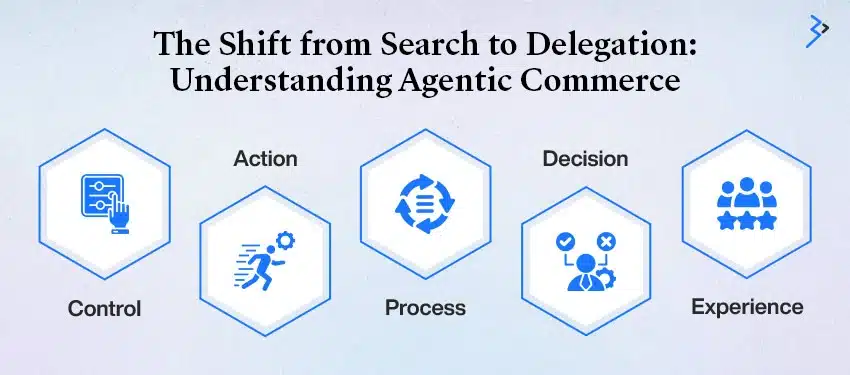
To prepare your store, you must first understand the core idea behind Agentic Commerce. It marks a major shift in how people shop online, where AI-powered digital agents can browse, compare, and even buy products for customers. Instead of shoppers doing all the searching themselves, these intelligent agents act on their behalf, finding the best deals and making quick, personalized purchasing decisions.
| Aspect | Current Model: Transactional eCommerce | Future Model: Delegated Agentic Commerce |
| Control | The store controls the interface and shopping journey. | The customer delegates control to a personal AI shopping agent. |
| Action | Customer executes a search query (e.g., “best organic coffee grinder”). | The customer gives the AI agent a goal (e.g., “Find me a high-quality coffee grinder under $150 that fits my kitchen aesthetic and delivers by Friday”). |
| Process | The eCommerce platform displays a filtered list of products and reviews. | The AI agent autonomously interacts with multiple brand storefronts and marketplaces via an API layer designed for machine-to-machine communication. |
| Decision | The customer manually compares options, reads reviews, and clicks “Buy.” | The AI agent returns a single, vetted recommendation, or completes the purchase automatically. |
| Experience | Reactive, manual, and time-consuming. | Proactive, automated, and personalized. |
Your store will soon negotiate, transact, and communicate with an AI rather than a human user. This transition requires a new level of data structure, transparency, and machine-readable services.

Pillar 1: Re-engineering Data for Agent Intelligence
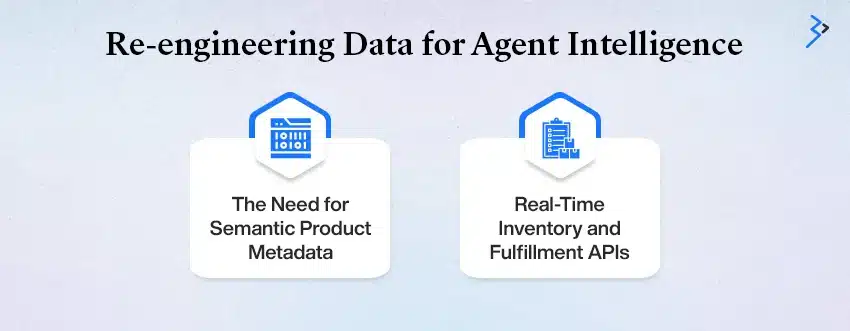
The most crucial step in preparing for Agentic Commerce is overhauling your product data structure. AI agents do not rely on beautiful product pages; they rely on rich, granular, and machine-readable data.
The Need for Semantic Product Metadata
Traditional eCommerce platforms primarily use keywords for search. Agentic Commerce requires semantic data, which defines a product’s relationship and context.
- Legacy Data: Name: “Espresso Machine Pro X.”
- Agentic Data: Is-a: “Semi-automatic Espresso Machine.” | Feature: “Integrated Grinder.” | Compatibility: “Uses E.S.E. Pods, Also Accepts Ground Beans.” | Environmental-Impact: “Energy Star Certified.”
You can enhance your product catalog by including metadata that clearly defines:
- Non-Visual Attributes: Dimensions, weight, warranty details, energy consumption ratings, and material composition (e.g., “BPA-free,” “recycled plastic”).
- Cross-Reference Data: Clear IDs for accessory compatibility, necessary add-ons, and bundle logic.
- Contextual Uses: An effective description that encompasses not just the product itself but also its intended uses. For example, phrases like “ideal for small apartments” or “best for long-distance running”.
- Actionable Insight: Adopt or adapt structured data standards like Schema.org or utilize GraphQL endpoints to help agents efficiently answer queries with the data they need without crawling irrelevant pages.
Real-Time Inventory and Fulfillment APIs
An agent will not waste time browsing unavailable products or with uncertain delivery timelines. Your backend systems must expose real-time, accurate data via dedicated APIs:
- Actual Stock Levels: Instant verification of inventory across all distribution centers.
- Dynamic Pricing: Agents will seek the best price across all providers, demanding dynamic, API-driven price negotiation capabilities.
- Precision Fulfillment Data: Guaranteed delivery dates, carrier options, and the estimated carbon impact of shipping are all available in milliseconds.
Pillar 2: Implementing Agent-Facing Commerce Services
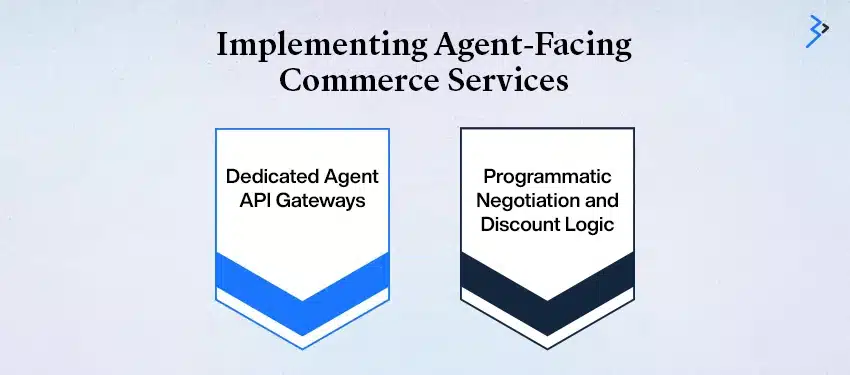
Agentic Commerce moves the transactional endpoint from the customer-facing interface (the “Buy Now” button) to a machine-facing API layer. Your eCommerce platform must be ready to accept and process machine-initiated orders.
Dedicated Agent API Gateways
You need a secure, high-performance gateway to receive requests from external AI agents. This dedicated gateway helps you:
- Authenticate Agents: Verify the identity and permissions of the agent to prevent fraud and spam.
- Optimize Performance: Handle high volumes of simultaneous, rapid-fire queries that would overwhelm a traditional web server.
- Rate Limiting: Implement strict controls on the number of requests an agent can make to protect your infrastructure.
Programmatic Negotiation and Discount Logic
If an agent is comparing five stores, it may initiate a negotiation protocol to secure the best deal. Your platform needs built-in logic to handle this automatically.
- Bid Management: Define minimum acceptable margins and maximum discount thresholds that the API can offer the agent without human intervention.
- Bundle Creation: Agents will look for complex solutions. Your system should be able to instantly generate and quote custom product bundles or subscription packages based on the agent’s complex criteria.
Precedence Research estimates that AI in eCommerce will rise from USD 7.25 billion in 2024 to USD 64.03 billion by 2034 globally. This exponential growth indicates that agentic capabilities will soon be a mandatory feature, not a competitive differentiator.
Pillar 3: Adopting Agent-First Content Strategies
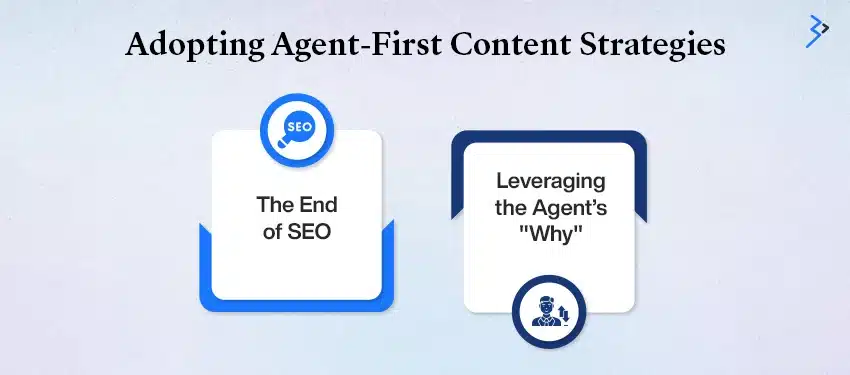
Agentic Commerce fundamentally changes the role of your marketing and content teams. They no longer write for emotional human engagement; they write for logical machine comprehension.
The End of SEO (As We Know It)
Traditional Search Engine Optimization (SEO) focuses on ranking high on Google’s search results page. In Agentic Commerce, the battleground moves to “Agent Optimization.”
- Prioritize Facts over Flair: Agents care about verifiable product attributes and performance data, not persuasive copywriting. Content should focus on clear, concise, structured answers to transactional and technical questions.
- Shift to Technical Documentation: Treat your product content like technical documentation. Use clear metadata tags, defined values, and structured data formats that an AI can easily ingest and verify.
Leveraging the Agent’s “Why”
While the agent handles the transaction, the human customer gives the agent an initial reason for the purchase. Your content must tap into these high-level objectives.
- Lifestyle Mapping: Tag products not just by category but by the lifestyle problems they solve (e.g., “sustainable living,” “remote office setup,” “kid-proof”). The agent can better align the product with the customer’s underlying goals.
- Trust Signals for Machines: Agents prioritize trust and reliability. Ensure your APIs expose precise, verifiable data on your security protocols, return policies, and authenticated third-party reviews.
Pillar 4: Operational Readiness and Security
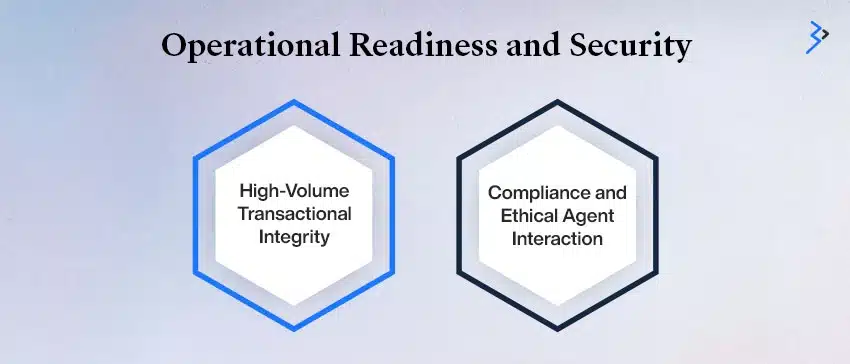
The final and most critical preparation phase involves ensuring your operational and security frameworks can support the new volume and complexity.
High-Volume Transactional Integrity
Agents can initiate a large number of purchases simultaneously. Your payment gateways and order management systems (OMS) must scale rapidly to handle this SAP-HCM-level operational load.
- Microservices Architecture: A modular, microservices architecture is essential. It helps you scale the Order Processing Service independently from the Inventory Service, preventing bottlenecks when traffic spikes.
- Automated Fraud Detection: Standard fraud detection systems designed for human behavior may fail against sophisticated AI agents. Implement machine learning-based security layers that analyze traffic patterns specific to agent activity.
Compliance and Ethical Agent Interaction
The legal and ethical implications of machine-initiated transactions are complex. Your system must maintain compliance seamlessly.
- Automated Compliance Flags: The system should automatically tag and flag orders or negotiations approaching legal or regulatory limits (e.g., quantity restrictions, geo-fencing).
- Data Privacy for Agents: While agents are machines, they represent human users. Your data exchange APIs must adhere to all data privacy regulations (like GDPR and CCPA) at the machine-to-machine level.
According to Harvard Business Review, poor data quality costs U.S. organizations approximately $3 trillion annually. In the realm of Agentic Commerce, this issue becomes critical. If your data is flawed or inconsistent, autonomous agents might bypass your store, rendering you invisible to millions of potential customers.
The Path Forward: Agentic Optimization Strategy
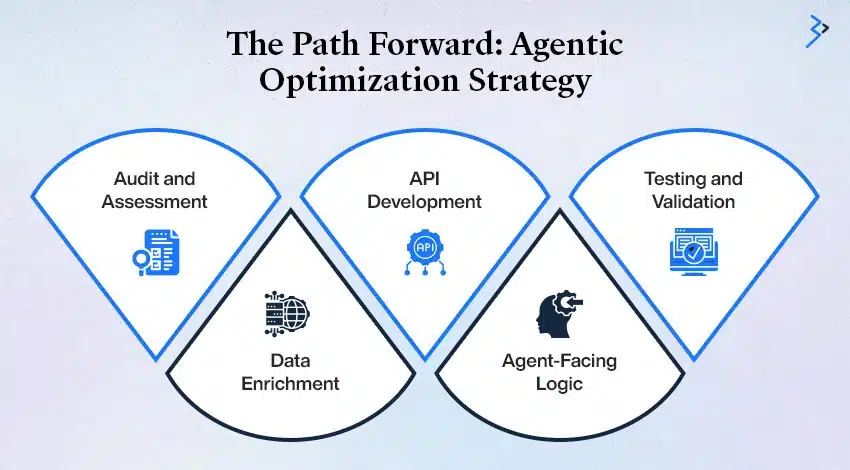
Preparing for Agentic Commerce is not a single project; it is an ongoing strategy of “Agent Optimization.” The goal is to build an eCommerce ecosystem that is equally welcoming and functional for the human user and the SAP Human Capital Management-level AI agent.
This preparation involves several iterative phases:
- Audit and Assessment: Analyze your current product catalog and core commerce platform’s readiness for granular, real-time data exposure.
- Data Enrichment: Implement a PIM (Product Information Management) system to structure and enrich data beyond simple keywords.
- API Development: Build and secure a high-performance, SAP HCM-grade API gateway dedicated to agent interaction.
- Agent-Facing Logic: Develop programmatic negotiation, bundling, and dynamic pricing rules.
- Testing and Validation: Test your agent APIs against simulated autonomous purchasing behaviors.
According to a report by Deloitte, a mere 0.1-second improvement in mobile site speed resulted in an 8.4% increase in retail conversions and a 9.2% rise in average order value.
Conclusion: Partnering for the Agentic Future
The transition to Agentic Commerce is essential for staying competitive. It requires completely redesigning your digital storefront for machine-speed operations, necessitating specialized expertise. This involves creating robust API gateways, maintaining data integrity, and integrating real-time fulfillment across ERP and PIM systems.
At Brainvire, we guide organizations through this transformation by designing scalable and secure Agentic Commerce solutions. These help you remain visible and competitive in the evolving digital retail landscape. Partner with us to future-proof your eCommerce operations.
FAQs:-
Agentic Commerce uses AI-powered shopping agents to automatically find, compare, and buy products. Unlike traditional eCommerce, where customers browse manually, agents communicate directly with brand APIs to handle pricing, fulfillment, and delivery on the user’s behalf.
AI-driven shopping is accelerating fast. Brands using outdated platforms risk becoming invisible to these agents. Preparing now with structured data, APIs, and real-time systems ensures you stay discoverable and competitive in this new ecosystem.
Adopt structured product data (like Schema.org), real-time inventory and pricing APIs, and secure agent gateways. Enable your system to support dynamic pricing, product bundling, and automated negotiations to meet agent-driven expectations.
SEO will evolve into Agent Optimization, writing and structuring content for AI comprehension, not just humans. Rather than purely persuasive copy, focus on clear facts, metadata, and verified product details.
Brainvire helps brands build scalable, secure, and API-driven eCommerce ecosystems. From data structuring to real-time integration, we prepare your store for Agentic Commerce and ensure long-term digital competitiveness.
Related Articles
-
Best Gen-AI-Based Customer Service Chatbots
In 2025, businesses will increasingly turn to Generative AI-based customer service chatbots to provide seamless and personalized customer experiences. These chatbots leverage advanced natural language processing (NLP) and AI algorithms
-
How Artificial Intelligence Trading Technology is Educating Stock Market Investors?
Have you seen the equations that experienced traders make in their heads? Or have you seen how recent trades are being recorded while current data is being monitored in movies?
-
Guide on SearchGPT: AI-Based Search Feature
Introduction The concept of organic search isn’t new to business owners! Over the last two decades, Search Engine Optimization (SEO) has driven organic visibility for brands and businesses worldwide. Nearly




